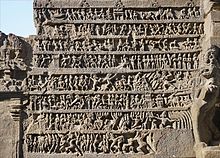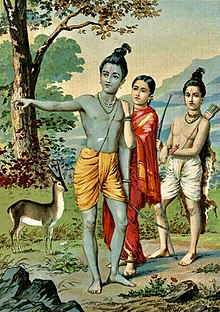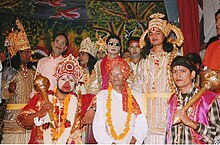Ramlila

| Part of a series on |
| Hinduism |
|---|
 |
Ramlila (
| Ramlila | |
|---|---|
 A scene from annual Ramlila at Ramlila Maidan, New Delhi, 2012 | |
| Status | active |
| Genre |
|
| Frequency | Annually |
| Venue | Ramlila Maidan |
| Location(s) | Ramlila Maidan, New Delhi, Delhi, India |
| Coordinates | 28°38′31″N 77°13′51″E / 28.641892°N 77.230698°E |
| Country | India |
| Years active | 1625–present |
| Inaugurated | 1625 |
| Founder | Megha Bhagat |
| Previous event | During Dussehra 2023 |
| Next event | During Dussehra 2024 |
Rama is the seventh
The Ramlila festivities were declared by
Etymology and nomenclature
Ramlila is a compound Sanskrit words "Rama" (a Vishnu avatar) and "Lila" (play, game, sport). According to James Lochtefeld, the word connotes a "playful drama about Rama", where it is both entertainment and a "deeply serious religious act" that has spiritual significance to both the actors and the audience.[1]
A literal translation of Ram Lila, states Norvin Hein, is "Rama's sport" where the term "sport" is best understood in a theological context. According to the Vaishnava thought, the Supreme Being (Vishnu) does not need to create the empirical world, he just descends as an avatar and manifests in the empirical world to "spontaneously, joyfully, disinterestedly play a part" or engage in "sports".[13]
The teams or companies of actors that train together and perform Ramlila are called Mandalis.[13]
History

Performance arts are an ancient Indian tradition, with the Sanskrit
Let Nātya (drama and dance) be the fifth vedic scripture.
Combined with an epic story,
tending to virtue, wealth, joy and spiritual freedom,
it must contain the significance of every scripture,
and forward every art.
Ramlila is one of many performance arts-related festivities within Hinduism.[1] Ramayana epic is dated to the 1st millennium BCE, and is one of the oldest Itihasa genres of Indian literature. It is unclear however as to when the first performances of Ramlila were held. The first enactment of Ramcharitmanas by 16th century Tulsidas is undocumented, but according to the tradition, his student Megha Bhagat started the Ramcharitmanas-based Ramlila in 1625.[6] According to Norvin Hein, a professor of Divinity and of Religious Studies specialising in Indology, Ramlila was in vogue before 1625, at least in North India between 1200 and 1500 CE, but these were based on Valmiki's Ramayana.[6][18][19] According to Richard Schechner, the contemporary Ramlila has deeper roots, as it incorporates both the teachings of ancient Sanskrit texts and modern theatre techniques.[20]

According to John Brockington, a professor of Sanskrit specialising in Indian epics, Ramlila is likely an ancient tradition of India because it is generally accepted by scholars that written manuscripts emerged later in Indian religions, and ancient texts were largely a product of oral tradition.[22] Thus, not only Ramalila, but all ancient epics of India must very likely have been recited and transmitted by bards and students in Ramlila-like manner, verbally from one generation to another, and consistently preserved across a wide geographic region by rules of acting by many teams. Further, states Brockington, the Hindu epics are too vast, with the Ramayana containing 20,000 verses and the Mahabharata with 100,000 verses, to have been preserved over two thousand years without being written down and without reciting and acting out. It is therefore unlikely that the Ramlila tradition emerged only in the modern era.[22]
Some colonial-era Indologists suggested, adds Brockington, that the Ramayana is a modern era text, but this hypothesis has since been abandoned because the existence of the Hindu Ramayana has been attested in Jainism literature, Ramayana reliefs in cave temples such as Ellora Caves, and southeast Asian temple carvings and culture by the 1st millennium CE.[22][23][21]
According to Norvin Hein, the contemporary Ramlila started once the Manas text of Tulsidas had been composed in the 16th century. However, states Hein, a dance-drama form of Ramayana enactment flourished at least in the Mathura region much earlier, possibly around the early centuries of the common era by the
James Prinsep wrote an eyewitness description of Varanasi Ramlila festivities in 1825, while H. Niehus wrote another from Ghazipur in 1905.[13] Norvin Hein described the Ramlila of 1949 and 1950, a period of socio-political turmoil in India after the British India partition of the subcontinent into India and Pakistan. Hein reported his observations from Ramilila in Mathura.[13]
Description

The Ramlila is the story of Hindu god Rama from his birth. The epic recites his childhood along with those of others who are major characters in it, such as Sita, Lakshmana, Ravana and others. It includes chapters on the marriage of Sita and Rama, the exile of Rama because Dharma requires him to give up his throne, Sita and Lakshmana joining him in the exile, their journeys through India and they meeting revered Rishis of Hinduism, the abduction of Sita by demon Ravana, the sorrow of Rama and Lakshmana, their hopelessness, how they creatively build an army from other living beings in the forest such as monkeys, their journey to Lanka to confront Ravana, the battle between the good and evil, the destruction of Ravana, the return of Rama to Ayodhya and as king, and the life thereafter.[2][25][26]
Ramlila festivals play this story. It is organised in numerous villages, towns and neighbourhoods during the autumn

Traditionally organised in a makeshift open-air theatre at night, it is usually staged by amateur acting teams drawn from all segments of the society.[2][25] Singers and musicians, men and women, elderly and youth play different parts, sing the verses to music, recite dialogues. The recitations and the narrative of the play are usually based on Ramacharitamanas. The dialogue is improvised, and often responsive to audience reactions. Dhol drummers and other musicians participate. The atmosphere is usually festive and free, with the audience whistling and commenting as the story proceeds. The stage is surrounded by food stalls and larger productions have a fair nearby. Surrounding areas temporarily transform into bazaars to cater to the audience. A committee (samiti) heads the preparation.[25] In many rural areas, traditional venues for Ramlila have developed over the centuries, and hundreds of people will often make the trip nightly to attend the play, by walking over miles like a religious pilgrimage in earlier times. Actors typically don't get paid, or get paid little for their efforts, but they are provided free food and accommodation by the villagers or committee. Performance costs are usually financed by fundraising in the community, often by self-organized Ramlila Committees.[2][25][27] The early-twentieth-century poem Radheshyam Ramayan by Pandit Radheshym Kathavachak is commonly used in Ramlila theatre because of its commentary on the political climate at the time in addition to the use of simple language and symbolism. The dialogue within the poem suit the "themes and dramatic styling" of Ramlila's performance for both battle scenes and more "rousing" scenes.[28]
A Ramlila is not a simple play acted out in a drama theatre, but it is structured to encourage and allow the audience to participate. In major productions, the audience walks with the actors from one site to another, they chant or co-recite passage, they immerse themselves as minor or significant characters in the play, while the major roles are played by a troupe of artists. The audience cheers when the good gets the upper hand, they are sorrowful when a wrong happens such as the kidnapping of Sita and her imprisonment against her will by demon Ravana. They participate in the burning of the effigies, and the community is welcome during the return of Rama back to Ayodhya. It is theologically an immersion experience.[29][30]
Regional variations

Today, several regions have developed their distinctive form of Ramlila, Uttar Pradesh itself has numerous variants of presentation styles, most prominent among them is that of Ramnagar, Varanasi which is a 31-day event, while most Ramlila elsewhere are typically abridged 10-day events climaxing in Dussehra.[2][25]
Other variants include the pantomime style is visible in jhankis or tableaux pageants, where colourful Jhankis and pageants depicting scenes from the life of Rama are taken out through the city.[31] According to a 2008 UNESCO report, the most notable Ramlila traditions are those observed annually at Ayodhya, Ramnagar and Varanasi, Vrindavan, Almora, Satna and Madhubani.[11]
Another variant is the
Ramlila at Ramnagar, Varanasi
The tradition of staging the Ramlila at

The Ramlila is a cycle of plays that recounts the epic story of

Preparations begin, weeks before its commencement, even the audition process is traditionally attended to by the Maharaja, where Svarupas, literally divine embodiment, the various characters of the Ramayana, are chosen from amongst local actors. Important roles are often inherited by families, for example, the role of

During the performance, there is a double transformation of the space within the city, as it first transforms from a city to theatre and then to mythic geography, as the scale of the performance is gradually increased to mythic proportions, coming down only in the end, when Rama finally returns home, this is when the Raja himself becomes part of the theatre thereby incorporating local element into the story itself. In the end, as the swarups, actors depart, they take off their garlands and offer it to Royal family members and give
Though several local legends exist regarding the beginning of this Ramlila, including one of which suggests that it was first staged at a nearby village, Chota Mirzapur as the one at Varanasi was disrupted due to the floods in the Ganges, from where it evolved to the present Ramlila, which is by far the most traditional rendition of the Ramayana, and has been a subject of study by scholars from all over the world for many decades now.[41]
On the last day, the festivities reach a crescendo as
Shri Sitaram Dharmmandal, Saraiharkhu Jaunpur
Saraiharkhu is a village situated in Jaunpur, Uttar Pradesh in India on the Janpur – Lucknow road, about 18 km (11 mi) from the city of Jaunpur. Ramleela here started in 1932 during British time and from then its played every year continuously with the grace of God during Dussera and celebrated Silver, Golden and Diamond jubilee.
The main aim of this organization is to distribute
Geographic spread

Over the centuries, Ramlila has evolved into a highly venerated art form and has travelled to far corners of the globe, through
The Rama story is also enacted in another popular art form as a nighttime fire shadow or day time puppet show. This is known as Tolapavakuthu in Kerala, Ravana chaya in Odisha, Nang sbek thom in Cambodia, Nang yai in Thailand and Wayang purwa in Indonesia.[43]
References
- ^ a b c d James G. Lochtefeld 2002, p. 389.
- ^ JSTOR 1145152.
- ^ Encyclopedia Britannica 2015.
- ^ a b c d e f Ramlila, the traditional performance of the Ramayana, UNESCO
- ISBN 1-85109-636-1. Page 42.
- ^ ISBN 978-0-415-93919-5.
- ISBN 978-9971-69-339-8.
- ^ Constance Jones & James D. Ryan 2006, p. 457.
- ^ a b James G. Lochtefeld 2002, pp. 561–562.
- ISBN 978-0-19-516832-7.
- ^ a b Ramlila – the Traditional Performance of the Ramayana UNESCO.
- ^ Ramlila – The traditional performance of Ramayana – Part I & II Indira Gandhi National Centre for the Arts
- ^ JSTOR 538562.
- ISBN 978-0-8133-4666-3.
- ISBN 978-1-61117-108-2.
Quote: "A summation of the signal importance of the Natyasastra for Hindu religion and culture has been provided by Susan Schwartz, "In short, the Natyasastra is an exhaustive encyclopedic dissertation of the arts, with an emphasis on performing arts as its central feature. It is also full of invocations to deities, acknowledging the divine origins of the arts and the central role of performance arts in achieving divine goals (...)".
- ^ "Natyashastra" (PDF). Sanskrit Documents.
- ^ Coormaraswamy and Duggirala (1917). "The Mirror of Gesture". Harvard University Press. p. 4.; Also see chapter 36
- ISBN 978-0300011975, pages 70-125
- ISBN 978-0292735040.
- ISBN 978-8170460183.
- ^ ISBN 978-0-19-516832-7.
- ^ ISBN 90-04-10260-4.
- ISBN 978-0-8348-0524-8.
- ISBN 978-0-520-06690-8.
- ^ JSTOR 538562.
- ^ David R. Kinsley 1989, pp. 91–108.
- ^ ISBN 978-0-415-04689-3.
- ^ Lothspeich, Pamela. "Ras and Affect in Ramlila (and the Radheshvam Ramayan).” Asian Theatre Journal, vol. 36, no. 1, Spring 2019, pp. 1-27, EBSCOhost, doi:10.1353/atj.2019.0001
- ISBN 978-0-520-06690-8.
- ISBN 978-0-415-04689-3.
- ^ Ramlila Archived 4 July 2008 at the Wayback Machine Department of Tourism, Government of UP, Uttar Pradesh.
- ^ Ramlila in Uttar Pradesh www.bharatonline.com.
- ^ Ramleela – Ramnagar Varanasi Official website.
- ^ ISBN 978-81-87780-04-5.
- ^ A Maharajah´s Festival for Body and Soul The New York Times, Monday, 30 March 2009.
- ISBN 978-0-415-04689-3.
- ^ a b Ramlila: The Performance in Ramnagar University of North Texas.
- ISBN 0-86132-046-8. Page 238.
- ^ Ramlila of Varanasi VaranasiGuru.com.
- ^ ISBN 0-415-04689-0. Page 169.
- St. Thomas University.
- ISBN 978-0-521-43437-9.
- ISBN 978-0-19-516832-7.
44. Shri Sitaram Dharmmandal, Saraiharkhu Ramleela www.dharmmandal.com
Bibliography
- Cynthia Bradley (2012). Denise Cush; Catherine Robinson; Michael York (eds.). Encyclopedia of Hinduism. Routledge. ISBN 978-1-135-18979-2.
- Alain Daniélou (1991). The Myths and Gods of India: The Classic Work on Hindu Polytheism from the Princeton Bollingen Series. Inner Traditions / Bear & Co. ISBN 978-0-89281-354-4.
- Constance Jones; James D. Ryan (2006). Encyclopedia of Hinduism. Infobase Publishing. ISBN 978-0-8160-7564-5.
- David Kinsley (1988). Hindu Goddesses: Visions of the Divine Feminine in the Hindu Religious Tradition. University of California Press. ISBN 978-0-520-90883-3.
- David R. Kinsley (1989). The Goddesses' Mirror: Visions of the Divine from East and West. State University of New York Press. ISBN 978-0-88706-835-5.
- James G. Lochtefeld (2002). The Illustrated Encyclopedia of Hinduism: N-Z. The Rosen Publishing Group. ISBN 0-8239-2287-1.
- ISBN 978-3447025225.
- "Navratri – Hindu festival". Encyclopædia Britannica. 21 February 2017. Retrieved 21 February 2017.
- Actors, Pilgrims, Kings And Gods: The Ramlila of Ramnagar, by Anuradha Kapur, Seagull, 2006. ISBN 1-905422-20-2.
- "Peasants in the Pacific: A Study of Fiji Indian Rural Society," Adrian C. Mayer, Routledge & Kegan Paul, London, 1973.
- "The Cambridge Guide to Asian Theatre," James R. Brandon, Cambridge University Press, 1997.
External links
- Ramlila at Ramnagar Fort Varanasi-find all info
- Shri Sitaram DharmMandal, Saraiharkhu Jaunpur Ramleela from 1932https://www.dharmmandal.com/

